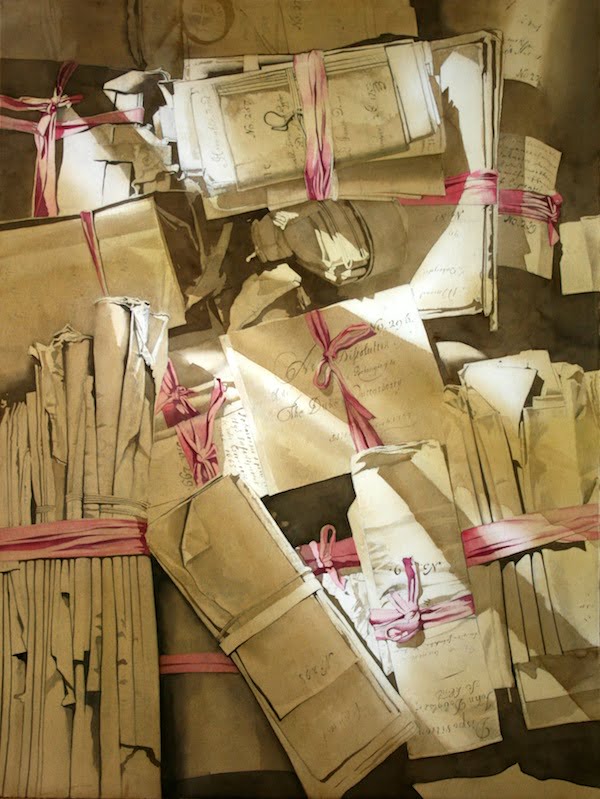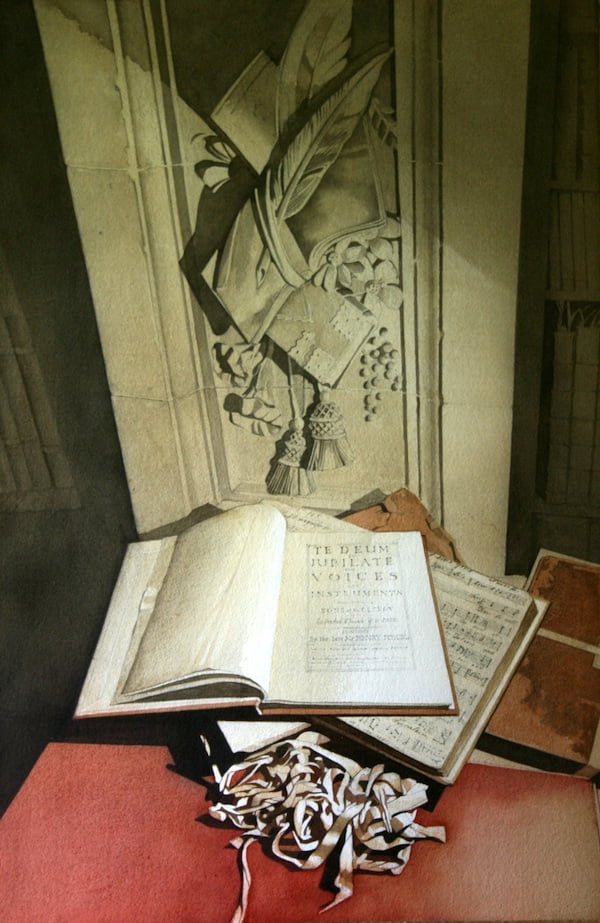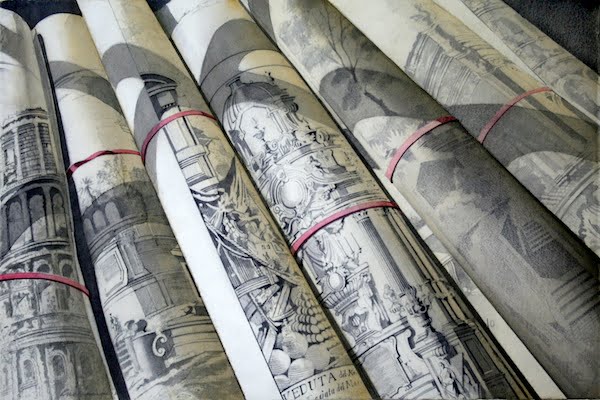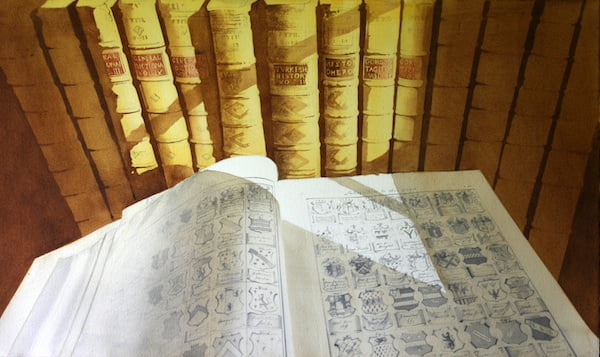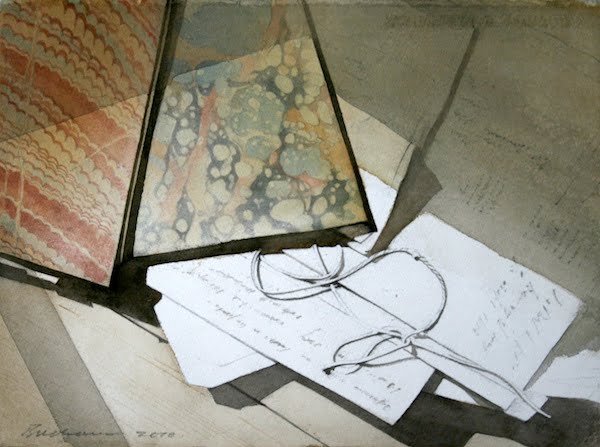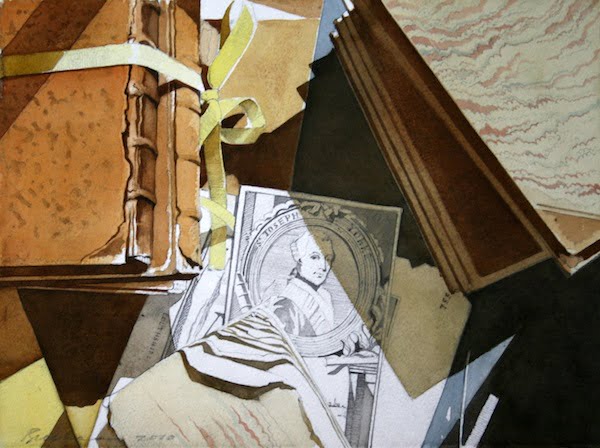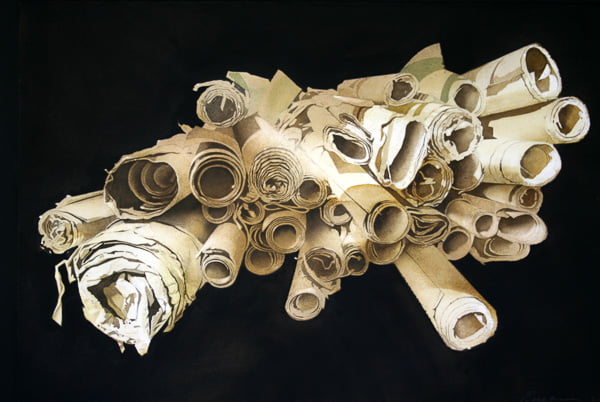Words and Deeds
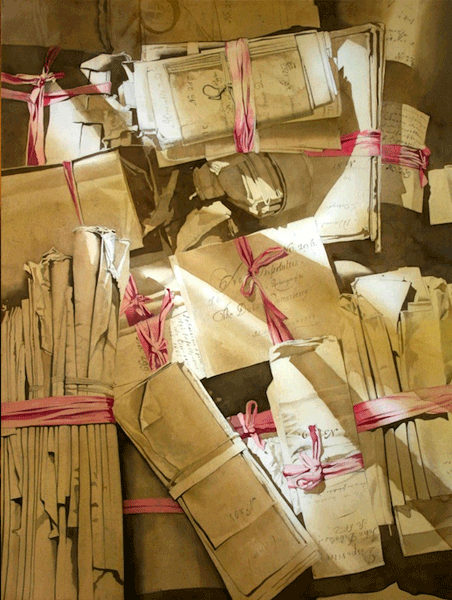
The Francis Kyle Gallery, London, 2010
REVIEWS
THE MYSTERY OF FALLING LIGHT
Great Britain is unique in Europe in not having been invaded or fought over for centuries, and thus retaining undisturbed a wealth of old libraries and ancient archives in country houses, university colleges, cathedrals and churches. Many of these places are known only to their owners or visiting scholars. This ‘forgotten’ or ‘secret’ quality is part of their magic. They have a distinctive aura of ancient peace, the home of memories where the past seems more real than the present, places where silence reigns, broken only by the buzz of an insect waking from hibernation and dust motes floating in a ray of light from opened shutters at the window. The ancient calm is palpable.
Such is the subject which Hugh Buchanan has tackled in his new exhibition, developing the theme of his previous Library Paintings to focus in detail on the contents of muniment rooms, Charter rooms and old libraries. The result is a group of striking and original still lives composed of paper, vellum, engravings, music scores, seals, red tape, string and crumbling bindings; they form vivid private glimpses into the past, into the undisturbed antiquarian sub-strata of British civilization.
These are wonderful pictures with something of the arresting simplicity of Spanish seventeenth-century still lifes. In place of blanched asparagus, onions and glazed pots, we see here sheets and rolls of paper, marbled covers, stiff string and vivid pink ribbon. Old documents could have a monochrome quality, but in Hugh Buchanan’s vision this is far from the case. There are considerable variations of tone and colour: in the paper of different types and dates, some brown with the passage of ages, the outer sheafs grey with ingrained dust, the insides still pristine white. Some documents are caught in shade, some transfigured by rays of light, with the shadows of glazing bars, or brass bookcase lattice falling across the pages. The yellows of oak shelves and the reds and chocolate of mahogany surfaces; the mulberry ink of duty stamps and the crimson of morocco book labels add flashes of unexpectedly vivid colour.
The compositions are masterly, often almost abstract, with fanned arrays of long-forgotten correspondence, neat stacks of ribboned deeds, or just the crumpled corners of an old account book and layered glimpses of eighteenth-century plans, shown in close-up focus like a zoom lens. An Accumulation of Engravings showing stacked tube-like rolls is a virtuoso exercise in perspective and foreshortening, light and shade. The brittle, battered, crumpled qualities of antique archives are here miraculously caught in water colour on paper.
The originality of these remarkable watercolour paintings, a study of paper on paper, is captured in the titles: Dead Flies, Dust and Tax Demands; Notes and Queries; Sasine no. 314; Marbled Packets. They strike a particular historical chord. Some of the finest set-pieces were composed and painted in the Charter Rooms at Drumlanrig Castle and Traquair House in Scotland, but Worcester College Library, Oxford, St. Paul’s Cathedral Library, The Soane Museum, Harewood House, and the New Register House at Edinburgh are evidence of a nation-wide geographical spread.
Not the least of the qualities to be seen in Hugh Buchanan’s work is its clarity. The writing on old letters, music scores, the charges of coats of arms, the architectural detail in Piranesi engravings or plans of the Edinburgh New Town is all perfectly represented and can be read and identified despite foreshortened perspective or play of light and gloom of shadows.
Hugh Buchanan’s is an exciting, original and highly impressive personal vision which combines an almost surreal sensibility with unparalleled virtuosity in the handling of wash, watercolour, pencil and ink. Above all there is a perfect marriage between the subject and its depiction. This exhibition is visually satisfying and impressive to a special degree for that reason.
JOHN MARTIN ROBINSON 2010
